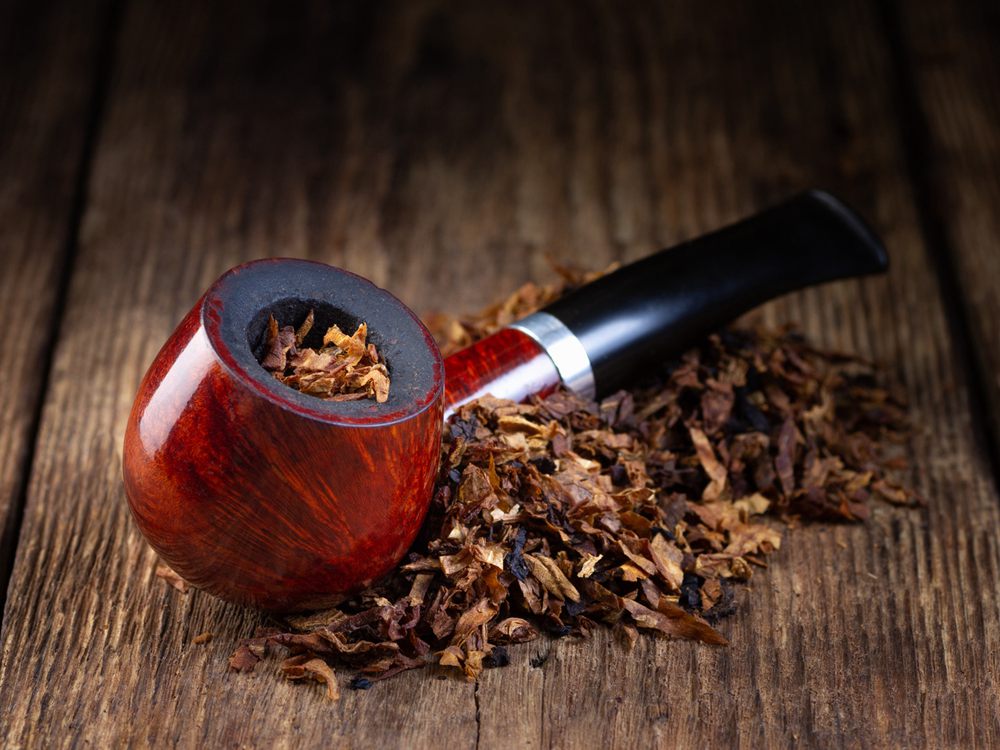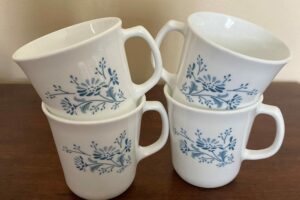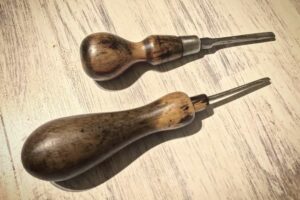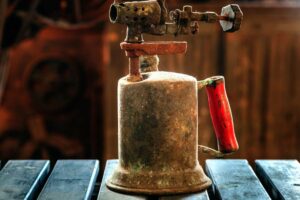Delving into the world of antique tobacco pipes can be both fascinating and rewarding. As you start your journey in discovering the rich history and variety of these treasured collectibles, it is essential to understand how to identify and determine the value of these prized smoking instruments. With an array of materials and designs spanning centuries, antique tobacco pipes offer a unique insight into history, culture, and craftsmanship.
One of the first steps in identifying antique tobacco pipes is examining the materials used in their construction. Early Native Americans crafted pipes from clay or stone, while later artisans began experimenting with various woods for durability and carving ease. By the late 1700s to early 1800s, the preferred materials included alder, birch, boxwood, cherry, maple, oak, pear, and walnut. Other notable materials, such as meerschaum – a mineral called sepiolite – became popular for its intricate carving capabilities and durability.
As you explore the different types of tobacco pipes, it’s important to pay attention to certain features, such as markings, size, shape, and craftsmanship, which can greatly impact their value. Familiarizing yourself with renowned brands like Kaywoodie, Barling, and Castello, as well as the distinguishing characteristics of meerschaum, clay, and wood pipes, will help you build a solid foundation for appraising and appreciating these remarkable relics. By taking the time to learn about antique tobacco pipes, you’ll be better equipped to identify and determine the worth of these unique cultural and historical artifacts, making your collecting journey all the more exciting and fulfilling.
Table of Contents
The History & Evolution of Antique Tobacco Pipes
Antique tobacco pipes are a fascinating subject that sheds light into the history of different cultures and their smoking habits. In this section, you’ll learn about the development of these pipes over time and how they reflect the evolving customs and tastes of their users.
In the early days, around the 16th and 17th centuries, clay pipes were prevalent. These pipes originated in England and soon spread throughout Europe and the Americas. They were made from a variety of materials, including white kaolin clay, which was affordable and easy to shape. These early pipes had a simple design with a small, shallow bowl and a straight stem.
As tobacco became more popular in the 18th and 19th centuries, the designs of pipes evolved. European manufacturers began to produce porcelain and meerschaum pipes. Meerschaum, a soft mineral found mostly in Turkey, was highly prized for its ability to change color as the pipe was smoked. Intricate designs, such as faces or scenes, were carved into these pipes, making them highly desirable and collectible.
During this period, briar pipes also emerged. Made from the root of the Mediterranean heath plant, briar was valued for its heat resistance and durability. French artisans were the first to craft briar pipes in the 1820s, and their popularity spread quickly.
In America, the Native Americans had been using pipes made of stone or wood long before the arrival of the Europeans. Some of these early examples are known as calumets, or peace pipes. They were used not only for smoking but also for ceremonial purposes, symbolizing friendship and alliance.
Over the years, different materials and technologies were used to produce pipes. In the late 19th and early 20th centuries, manufacturers experimented with various metals, such as brass and silver, as well as materials like amber, ivory, and horn for the mouthpieces. Here are some popular types of antique tobacco pipes:
- Clay pipes: Highly affordable, made from white kaolin clay
- Porcelain pipes: Made in Europe, often decorated with paintings or intricate designs
- Meerschaum pipes: Carved from a soft mineral found in Turkey, changes color when smoked
- Briar pipes: Made from the root of the Mediterranean heath plant, highly durable
In conclusion, the history and evolution of antique tobacco pipes is a rich and diverse subject. As a collector or enthusiast, understanding this history can help you identify and appreciate the value of the various types of antique pipes you may encounter.
How to tell if Tobacco Pipe is Antique or old
To determine if a tobacco pipe is antique or old, you should start by examining the bowl form. The bowl form is often the most accurate way of dating a pipe, as the shapes changed rapidly over time. They were also subject to regional variations prior to the nineteenth century – the shape can help identify which part of the country a pipe comes from.
Look for materials that were commonly used in antique pipes. These include clay, which was a popular choice for pipes from the late 1500s to the 1800s. Stone, particularly meerschaum, was another popular material in the 1700s, known for its intricate carvings and porous nature, which allowed the pipe to change color over time, enhancing its appearance.
Next, assess the pipe’s markings and logos. There are many resources, such as the Pipedia website, where you can research and compare your pipe’s markings to those of historical brands and manufacturers. Keep in mind that some authentic antique pipes may have worn or faint markings, making them harder to identify.
Consider the craftsmanship and overall design of the pipe. Antique tobacco pipes often have more intricate and detailed carvings or designs, reflecting the skill and artistry of the makers. However, be cautious, as some modern reproductions may also feature detailed carvings to mimic antique pipes.
Lastly, consult with an expert or a knowledgeable community, such as pipe collectors’ forums or local antique dealers, when in doubt about your pipe’s age or authenticity. They can provide valuable insights and may be able to help you identify and authenticate your tobacco pipe. Remember, dating and valuing an antique tobacco pipe can be challenging, but when done accurately, it can be a rewarding experience.
2 Types of Antique Tobacco Pipe and Their Values
Clay Pipes
Clay pipes, particularly clay tavern pipes from the 1650s, were among the first manufactured types of tobacco pipes. These pipes were popular in the 17th and 19th centuries due to their affordability. However, their fragility was a significant drawback. To determine the value of your clay pipe, consider its:
- Age: Older pipes are usually more valuable.
- Condition: Damaged or cracked pipes have less value.
- Uniqueness: Rare and intricate designs may be more valuable.
Meerschaum Pipes
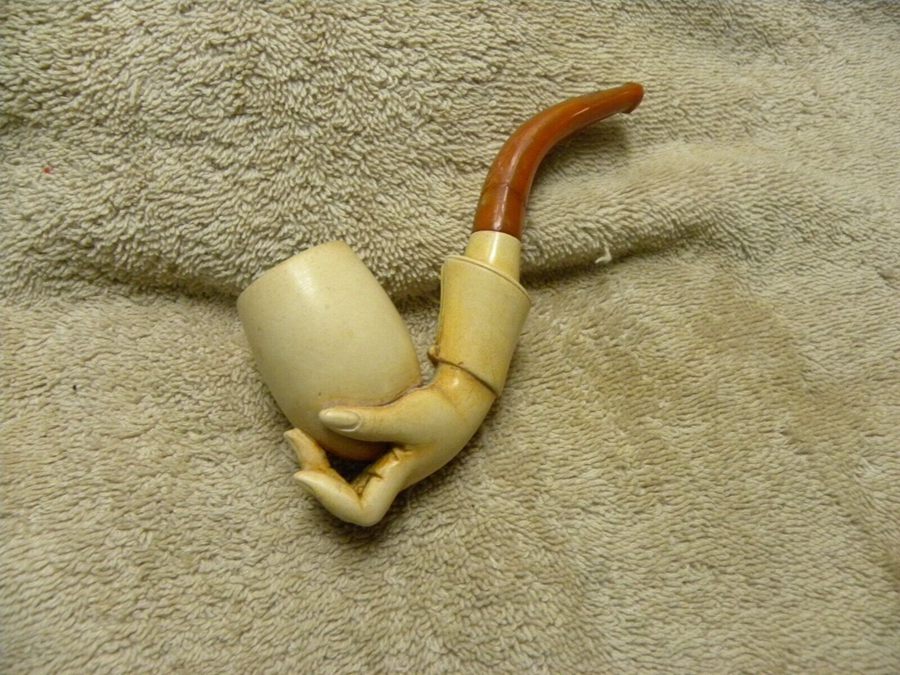
Meerschaum pipes, which gained prominence in the 1700s, are made from the mineral sepiolite and are often carved with intricate patterns. They are known for their cool and dry smoke, and due to their porous nature, the stone can draw moisture and tobacco tar, enhancing the color of the pipe over time. To assess the value of your Meerschaum pipe, take into account the following:
- Quality of carving: More detailed and skilled craftsmanship adds value.
- Coloration: A well-aged and colored pipe can be more valuable.
- Condition: Undamaged pipes in excellent condition are worth more.
7 Factors to Identify & Value Antique Tobacco Pipes
1. Age
The age of an antique tobacco pipe is a significant factor to consider when determining its value. Older pipes are typically more valuable than newer ones, as they often have unique characteristics, historical significance, or a higher degree of craftsmanship.
Dating Pipes by Bowl Form
One method used to estimate the age of a tobacco pipe is by examining its bowl form. The shapes of pipe bowls changed rapidly over time, and they were subject to marked regional variation prior to the 19th century. As a result, you can use the shape of a pipe bowl to identify the pipe’s age, as well as which part of the country it may have originated from:
| Bowl Form | Estimated Age |
|---|---|
| Conical, Narrow | Late 16th Century |
| Conical, Wide | 17th Century |
| Tapered, Cylindrical | Early 18th Century |
| Biconical | Mid-Late 18th Century |
| Rounded Bowl, Heel | 19th Century |
| Rounded Bowl, No Heel | Early 20th Century |
Tobacco Pipe Markings
Another method for determining the age of a pipe is by examining its markings. Some antique clay pipes have distinctive manufacturer markings or other identifying features etched into the bowl or stem. These markings can be used to approximate the age of the pipe and help establish a more accurate valuation:
| Tobacco Pipe Markings | Average Valuation |
|---|---|
| Early 17th Century Markings | $350 – 450 |
| Late 17th Century Markings | $300 – 400 |
| 18th Century Markings | $250 – 350 |
| 19th Century Markings | $200 – 250 |
| Early 20th Century Markings | $150 – 200 |
Keep in mind that these valuations are for pipes in good condition with minimal wear or damage. Pipes that exhibit significant wear or have been repaired may not hold the same value as those in better condition.
2. Brands
When identifying antique tobacco pipes, knowing various renowned brands is crucial as the brand name can significantly impact the value of the pipe. Some of the oldest and esteemed brands include Dunhill, Chacom, Peterson, Charatan, and BBB. These brands have produced exceptional quality pipes throughout history, and their vintage pieces are highly sought after by collectors.
Different factors contribute to the value of antique tobacco pipes within these brands, such as rarity, design, materials used, and presence of gold or silver bands. Here is a valuation table for antique tobacco pipe brands:
| Brand | Average Valuation |
|---|---|
| Dunhill | $500 – $750 |
| Chacom | $400 – $600 |
| Peterson | $300 – $550 |
| Charatan | $350 – $700 |
| BBB | $250 – $500 |
It is essential to note that these average valuations can change depending on specific factors such as rarity, design, and materials as mentioned earlier.
Knowledge of these brands and their history adds credibility when determining the value of an antique tobacco pipe. For example, Dunhill has been producing pipes since the early 1900s and is well-known for its innovation. Chacom, a French brand, has been crafting pipes since the mid-19th century, while Peterson is an Irish brand known for its distinct style since the late 1800s. Charatan, originating in London, is another esteemed brand founded in the 1860s, and BBB stands for Blumfeld’s Best Briars, recognized for its excellence since the late 19th century as well.
3. Material
When identifying and valuing antique tobacco pipes, the material used in their construction is one of the crucial factors to consider. Over the years, various materials have been employed, with each type impacting the pipe’s worth. In this section, we’ll explore some popular materials and their average valuations.
Clay Pipes
Clay was one of the earliest materials used for tobacco pipes, notably by Native Americans. Their clay or stone platform pipes featured flat bases and indigenous tobacco. Collectors find these early tobacco pipes to be valuable for their authenticity and historical significance.
| Material | Average Valuation |
|---|---|
| Clay Pipes | $200 – $300 |
Meerschaum Pipes
In 1720, English clay pipes transformed into Meerschaum pipes. Meerschaum, meaning “foam of the sea” in German, is a material found in Africa and Turkey, formed from the compressed deposits of ancient micro marine life. This material has a consistency of softened cheese, making it easy to carve intricate designs, which increase pipe value.
| Material | Average Valuation |
|---|---|
| Meerschaum Pipes | $250 – $500 |
Briarwood Pipes
Briarwood pipes gained popularity in the later period due to their durability and resistance to heat. These pipes, made from the root burl of the white heath tree, required great skill to create, resulting in premium and heirloom-quality tobacco pipes of varying prices.
| Material | Average Valuation |
|---|---|
| Briarwood Pipes | $100 – $500 |
As you identify and appraise antique tobacco pipes, it is essential to pay close attention to their material. The table above provides average valuations for varying materials. Note that these valuations are approximate, as the pipe’s exact worth is also influenced by factors such as brand, condition, age, and design intricacies.
4. Shape
When identifying and valuing antique tobacco pipes, the shape can be a distinguishing factor and can affect their overall value. There are numerous classic pipe shapes, each with its unique characteristics and style. Some of these shapes include Bulldog, Apple, Author, and many more.
Bulldog pipes are known for their straight, bent, or curved styles, while Apple pipes get their name from the round, apple-shaped bowl. An Author pipe is a subset of the Apple shape and is characterized by its large bowl, making it a favorite among smokers. These pipes can be made from different materials, such as meerschaum, wood, and porcelain, all of which can affect the value of the pipe.
To help you understand the average valuation of antique tobacco pipes based on their shape, the following table presents some examples:
| Antique Pipe’s Shape | Average Valuation |
|---|---|
| Bulldog (Straight, Bent, Curved) | $300 – 400 |
| Apple | $250 – 350 |
| Author | $400 – 500 |
| Meerschaum | $600 – 800 |
| Wooden | $200 – 300 |
| Porcelain | $150 – 250 |
5. Size
When identifying and valuing antique tobacco pipes, size is an important factor to consider. The size of the pipe can impact its value, as certain sizes and shapes may be more desirable to collectors.
During the 1660s to 1780s, tobacco pipes typically had medium-length straight stems with a broad end near the bowl. Stem bores of 6/64″ to 5/64″ were common in these pipes, as were elongated bases with a spur at the bottom. Late 18th-century pipes and later had finer clays and stem bores ranging from 5/64″ to 4/64″. Stems were thinner and varied in length, with nipple-type mouthpieces being used on some types after 1850.
The following table shows some common sizes and shapes of antique tobacco pipes along with their average valuations:
| Antique Pipe Size/Shape | Average Valuation |
|---|---|
| Medium-length straight stem | $400 – 500 |
| Elongated base with spur | $350 – 450 |
| Late 18th-century thin stem | $250 – 300 |
| Late 18th-century nipple-type | $200 – 250 |
| Early clay tavern pipe (1650s) | $150 – 200 |
6. Carving
Carving is an essential aspect when identifying and valuing antique tobacco pipes. The intricacy of the carving, the skill of the carver, and the subject matter can significantly impact the value of a pipe. In this section, we will explore the impact of carving on antique tobacco pipe valuation.
The level of detail in carving an antique tobacco pipe often reveals the pipe’s overall value. More elaborate carvings tend to attract higher prices, while simpler or rougher carvings may lower the pipe’s value. However, this is not a strict rule, as other factors such as rarity, age, and materials may still influence the value.
Subject matter is another crucial element in pipe carving. Pipes depicting historical events, famous people, or culturally significant themes may be worth more than those featuring generic designs. Adding to this, the presence of a carver’s signature or maker’s mark on the pipe can also increase its worth, as it indicates authenticity and quality.
Here’s a valuation table to help you understand the impact of carving on antique pipe values:
| Carving Detail | Average Valuation |
|---|---|
| Simple, rough carving | $100 – 150 |
| Moderate detail, basic designs | $200 – 300 |
| Intricate carving, recognizable subjects | $400 – 500 |
| Highly detailed, signed or marked | $600 – 800 |
7. Hallmarks
Hallmarks are essential to the identification and valuation of antique tobacco pipes. They indicate the maker, material, quality, and origin of the pipes. Collectors and appraisers often rely on these marks to determine the authenticity and value of a specific piece.
To identify the hallmarks on antique tobacco pipes, carefully examine the pipe’s bowl, stem, and shank. The marks might be stamped, engraved, or molded, depending on the material and maker. Here are some common hallmarks found on antique pipes:
- Manufacturer’s initials or name
- Country or city of origin
- Material used (e.g., meerschaum, briar)
- Model number or name
- Date or year of production
- Unique logos or symbols
When evaluating the price of antique pipes based on hallmarks, keep in mind that rarer, more intricate, or higher-quality hallmarks will generally contribute to a higher valuation. Here’s a table showcasing how specific hallmark factors affect the average valuation of antique tobacco pipes:
| Hallmark Factor | Average Valuation |
|---|---|
| Meerschaum with detailed carving | $200 – $300 |
| Briar pipe with simple design | $100 – $150 |
| Unique logos or symbols | $150 – $250 |
| Rare or indistinct hallmarks | $250 – $350 |
| Hallmarked pipes with historical significance | $400 – $500 |
Remember that these price ranges are only estimates based on the hallmark factor alone. Numerous other factors, such as condition, age, rarity, and provenance, will also play a role in determining the value of an antique tobacco pipe. Always consult an expert appraiser to accurately assess the value of any antique pipe you own or plan to purchase.
Final Thoughts
Throughout your journey in identifying and valuing antique tobacco pipes, it’s essential to consider various elements that contribute to their overall worth. Remember the following key factors to make informed decisions when assessing these unique collectibles:
- Look for distinct stem shapes and materials, as they can provide clues about the pipe’s age. Remember that real meerschaum and briar pipes are usually the most expensive, reaching prices up to $1,000 or more.
- Pay attention to pipe grades and shape numbers, as this information can help you date a pipe. For instance, a 4-digit shape number suggests the pipe might be from the pre-1936 era.
- Examine the pipe’s rod and metal cap on the bowl, as these features can indicate value. Keep an eye out for rare smoking collectibles, like the 125,000 dollar find from Dr. Lori.
- Familiarize yourself with historical pipe types, such as clay tavern pipes from the 1650s, to better understand the evolution of these items and their significance in the market.
By considering these aspects, you’ll be well-equipped to navigate the world of antique tobacco pipe collecting. Stay curious and observant, as you can always discover something new and valuable in this exciting niche.
FAQ
What types of antique tobacco pipes are most commonly found?
You might come across a variety of antique tobacco pipes, some of the more common types include:
- Clay pipes: Manufactured with an extra-long handle called the clay tavern pipe, they were popular and affordable in the 17th and 19th centuries. However, they were fragile and prone to breaking.
- Stone or wood pipes: Native Americans in the eastern woodlands of North America were the first to use tobacco pipes made of clay, stone, or wood with flat bases.
- Meerschaum pipes: These pipes are made from a soft, white mineral and are known for their intricate carvings. They date back to the 18th century and can be quite valuable.
How can I identify the materials used in an antique tobacco pipe?
Some materials that were used in making antique tobacco pipes include clay, stone, alder, birch, boxwood, cherry, maple, oak, pear, and walnut. To identify the material of your pipe, carefully examine its texture, weight, color, and carvings. Also, consider the area and time period the pipe originates from, as certain materials may have been more popular during specific times or in specific regions.
How do I determine the value of an antique tobacco pipe?
There are several factors that can affect the value of an antique tobacco pipe:
- Rarity: Pipes made from rare materials or with limited production runs tend to be more valuable.
- Condition: Pipes in good condition, without cracks, chips, or missing parts, are generally more valuable.
- Craftsmanship: Intricate carvings, unique design elements, and the overall quality of the piece can increase its value.
- Provenance: If you can trace the history of the pipe back to its original owner or maker, it may be more valuable.
- Brand: Some manufacturers, like Kaywoodie, produced collectible meerschaum pipes that can fetch higher prices.
To get an accurate value, you should consider consulting an antiques appraiser or researching similar pieces online to gauge the current market value.
How do I care for and maintain antique tobacco pipes?
Proper care and maintenance of your antique tobacco pipes can help preserve their value and keep them in good condition:
- Clean your pipe regularly: Use soft brushes or pipe cleaners to remove any residue or buildup inside the pipe. Be gentle to avoid causing any damage.
- Store your pipe safely: Keep your pipe in a cool, dry place away from direct sunlight or temperature fluctuations.
- Handle with care: When handling your antique pipe, use a gentle touch to avoid causing any damage or scratches.
- Repair damages: If your pipe is damaged or needs restoration, consult a professional to ensure the proper techniques and materials are used.

